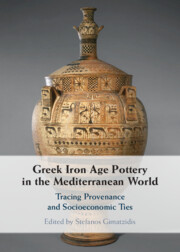Book contents
- Greek Iron Age Pottery in the Mediterranean World
- Greek Iron Age Pottery in the Mediterranean World
- Copyright page
- Contents
- Contributors
- Preface
- Abbreviations
- One Introduction to the Analysis of Greek Iron Age Pottery in the Mediterranean World
- Two Greek Iron Age Pottery in the Mediterranean World
- Three Greek Iron Age Pottery in the Mediterranean World
- Four The Social Context of Pottery Production, Exchange and Consumption in the Northern Aegean
- Five Geometric Pottery Production and Consumption in the Balkan Hinterland
- Six The Aegean Connection of East Locris
- Seven Early Iron Age Klazomenai
- Eight The Earliest Greek Colonisation in Campania
- Nine Late Geometric and Orientalising Pottery from Sicilian Naxos in Its Context
- Ten Early Greek Pottery on the Coast of Málaga, Andalusia, Spain
- Eleven Consumption of Geometric and Archaic Greek Pottery in the Emporion of Huelva (Tartessos, South-Western Spain)
- Twelve Greek Geometric Ceramics from Phoenician Utica
- Thirteen The Greek Geometric Pottery from the Tunisian Excavations at Utica
- Fourteen Early Iron Age Greek Pottery at Sidon
- Fifteen The Role of Aegean Imports and Aegeanizing Wares in the Phoenician Cemetery of al-Bass, Tyre
- Sixteen Concluding Remarks on Early Greek Pottery Production, Exchange and Consumption Overseas
- Catalogue of the NAA Samples and Results
- Appendix
- Index
- References
Fifteen - The Role of Aegean Imports and Aegeanizing Wares in the Phoenician Cemetery of al-Bass, Tyre
Published online by Cambridge University Press: 30 May 2024
- Greek Iron Age Pottery in the Mediterranean World
- Greek Iron Age Pottery in the Mediterranean World
- Copyright page
- Contents
- Contributors
- Preface
- Abbreviations
- One Introduction to the Analysis of Greek Iron Age Pottery in the Mediterranean World
- Two Greek Iron Age Pottery in the Mediterranean World
- Three Greek Iron Age Pottery in the Mediterranean World
- Four The Social Context of Pottery Production, Exchange and Consumption in the Northern Aegean
- Five Geometric Pottery Production and Consumption in the Balkan Hinterland
- Six The Aegean Connection of East Locris
- Seven Early Iron Age Klazomenai
- Eight The Earliest Greek Colonisation in Campania
- Nine Late Geometric and Orientalising Pottery from Sicilian Naxos in Its Context
- Ten Early Greek Pottery on the Coast of Málaga, Andalusia, Spain
- Eleven Consumption of Geometric and Archaic Greek Pottery in the Emporion of Huelva (Tartessos, South-Western Spain)
- Twelve Greek Geometric Ceramics from Phoenician Utica
- Thirteen The Greek Geometric Pottery from the Tunisian Excavations at Utica
- Fourteen Early Iron Age Greek Pottery at Sidon
- Fifteen The Role of Aegean Imports and Aegeanizing Wares in the Phoenician Cemetery of al-Bass, Tyre
- Sixteen Concluding Remarks on Early Greek Pottery Production, Exchange and Consumption Overseas
- Catalogue of the NAA Samples and Results
- Appendix
- Index
- References
Summary
The use of Aegean pottery – comprising a few drinking vases – is rather limited in the Iron Age cemetery of al-Bass in Tyre despite the large number of investigated tombs. This finding stands in contrast to the evidence recovered from the excavations at the settlement site of Tyre, on the ancient island, where a broad range of typologically variable Greek ceramics came to light. Nevertheless, the imported wares at the settlement seem to be represented by even lower percentages than those at the cemetery. This paper aims to analyse this discrepancy through various perspectives that include examination of typology, functionality, social dynamics and economics. The conclusions drawn from this analysis suggest that these non-local artefacts did not significantly alter the way in which the community of Tyre consumed wine. Instead, their deposition in burial and possibly other social contexts can be associated with issues of social status manipulation.
- Type
- Chapter
- Information
- Greek Iron Age Pottery in the Mediterranean WorldTracing Provenance and Socioeconomic Ties, pp. 456 - 475Publisher: Cambridge University PressPrint publication year: 2024

